August 31, 2018 October 31, 2018
Minions in PvP
You hear it all the time: you should always have a minion on the field while trying to get rid of your opponent’s. Minions get rid of enemy shields. They can buff you. They are a general nuisance and the cause of frequent arguments. Still, there is much more at play when it comes to minions.
Today we’re going to look a little deeper into the topic of minions. We’ll go over when you should use them, their pro’s and con’s, and what they do more generally.
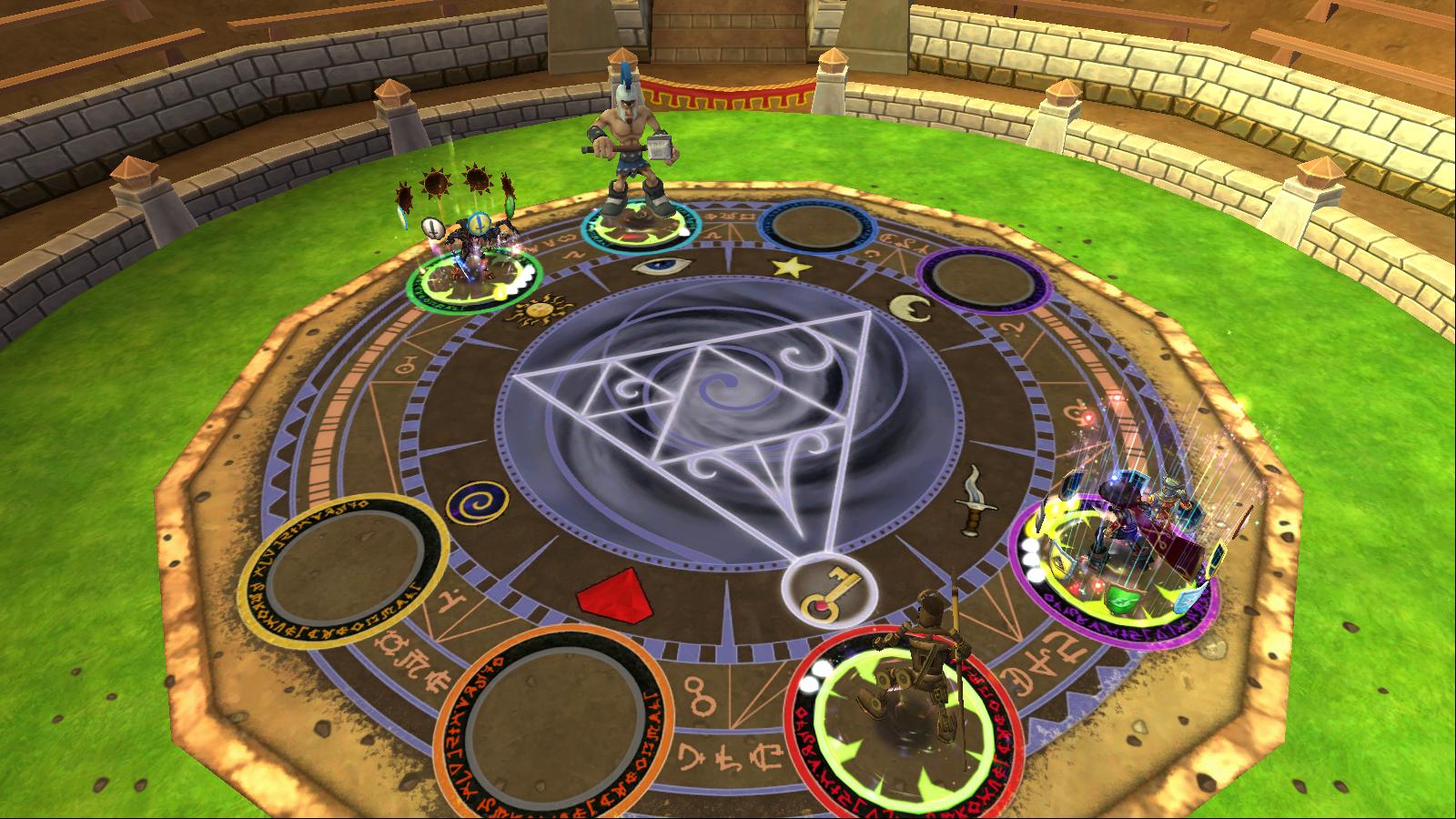
Advantages of having a minion up
Having a minion up brings lots of benefits. A minion will force your opponent to focus on killing it, which will give you at least one extra round to set up. No problem if they ignore the minion though! If they do that, the match can quickly snowball in your favor. While the damage they do is nothing special, there’s much more to this story.
- Their attacks will destroy the opponent’s shields. Do you have blades up but can’t find a wand to get rid of a tower shield? Your minion has you covered.
- They can blade and trap. An extra trap or stackable blade is always welcome when you’re setting up for that big hit.
- They can use utility or healing spells. This one depends on which minion you have. The point stands that most minions have some pretty fancy spells in their arsenal.
When you shouldn’t use them
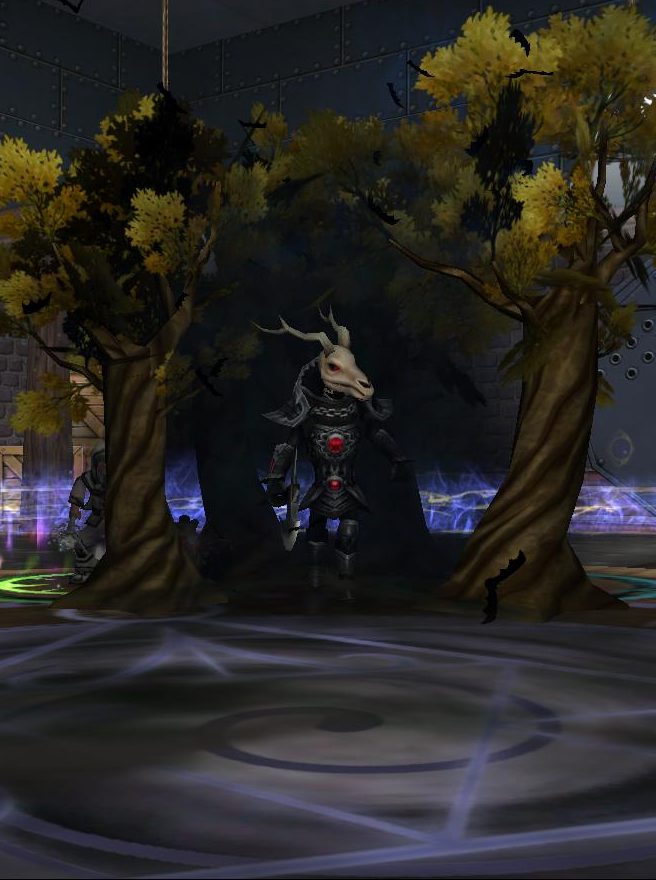 Everything looks nice and dandy so far, but there are also disadvantages to having a minion up. To be more specific, there are situations when it’s not wise to use them.
Everything looks nice and dandy so far, but there are also disadvantages to having a minion up. To be more specific, there are situations when it’s not wise to use them.
Firstly, when fighting offensive (non Jade-Juju) deaths. Death has a lot of spells in their arsenal to counter minions. The most dangerous ones are the hard hitting AOE Deer Knight and health draining Vampire. You will be giving your Death opponent free health! This can be a lot of health, as minions don’t generally have any resist.
Secondly, when the match is fast paced. This case is especially valid when facing a Storm wizard. If you didn’t establish your defenses yet, and you’re fighting a really agressive player, summoning a minion can get you killed. It’s true that the minion can shield you and help you establish defenses. However, sometimes the match can be over before the minion will even have an opportunity to shield you.
Lastly, it depends on your amount of pips. Summoning a minion will put you ahead of the opponent, but losing pips will put you back again. Before you call your loyal helper, check your own and your opponent’s pips. If you have only 2 power pips and your opponent has (almost) full pips, then don’t summon a minion. You won’t have any resources to heal if your opponent decides to attack soon after. If you do summon one, make sure you have defensive cards in hand to protect yourself while building up pips.
The minion’s behavior
So, let’s imagine: you’re in a match, and the situation is perfect to summon a minion. Hence, you summon one. Now, what can you expect your minion to do? Here are a few little things that will help you understand their behaviour. It’s the little things that sometimes make the difference in a match.
Your minion’s activation
Minions are inactive the round that you summon them. This means they can’t do anything and nothing can’t be done to them during this round.
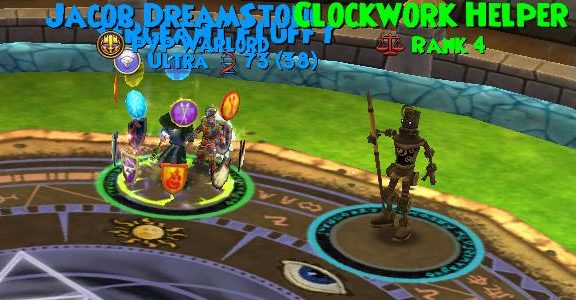
This is a good piece of information to keep in mind when you start first and know that your opponent is about to kill your minion. When your opponent has his kill-spell ready, but you replace the minion he was going to kill with a fresh one, the new one will not be hurt by the spell your opponent chose. Now, of course it’s not wise to keep resummoning minions left and right. But if your little helper has only a little health left, it’s not really worth wasting a tower shield on it. It will die soon (and you’ll summon a new one) anyway, so why not make opponent waste a turn in the process of doing it.
Minion AI
The next thing that’s important to know is your minion’s target. Usually minions will attack the biggest threat on the field — the same way monsters in PvE do. However, notice that this “threat factor” only activates AFTER they’re summoned. This means that if you have a minion up already and opponent summon the own one, his minion will treat both of you as equals until you or your minion gain his attention.
Let’s examine minions’ primary targets. Right after a minion is summoned, the primary target will always be the enemy directly across. This means, in 1v1, your opponent’s minion. If your opponent doesn’t have one up, your minion will focus on the player. This can be used tactically – if you want your minion to target another minion instead of player, just wait until your opponent summons his first.
In addition, this can be further manipulated by your opponent, who can heal or attack to gain the attention of your minion. The same is true for you if you find yourself in the opposite role. By attacking or healing, you can manipulate whether the opponent’s minion will focus on you or your helper. Deciding which of these two is the better option is up to you, but it mostly comes down to whose defense you want to be weakened.
Playing with minions
So this is the part that everyone is always talking about: having your own minion up and keeping your opponent’s down.
However, this can depend on the situation. Sometimes killing the minion would mean sacrificing a blade. Saving the blade instead of killing the minion can be great if you’re about to kill your opponent in the next few turns.
On the other hand, if you know that the match will last a bit longer, then kill it by any means necessary. Even if it means using your blades or losing your pips, just make sure the minion is down. While this might be counter-productive in the short run, in the long run you’ll be thankful you killed it.
On the flipside, make sure to keep YOUR minion alive. Shielding it is often a good idea, because this will force your opponent to do what we were discussing before: using extra pips to get rid of it. Some players even heal or put absorbs on their minions in order to prolong their life.
Types of minions
In this list, we’ll go over all the minions that are usable in PvP. This means we’ll skip, among others, the ones you obtain at level 75.
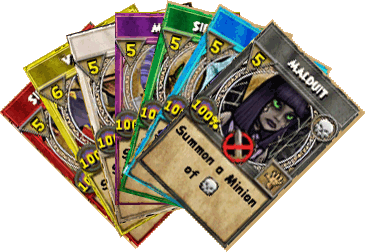
Balance
Mander
This is the first out of two trainable Balance school minions. If you don’t have a Clockwork Paladin pet (or you’re opting for a different pet), then the Mander is a great alternative. While it’s not as agressive as other minions, it is a utility beast.
It can shield you, blade you and even donate some pips. Besides that, it can also use weaknesses and black mantles. The latter is especially powerful when combined with the infamous Loremaster mantle. Due to lack of aggression, this minion won’t be very successful with shield breaking, since his only attacks are Locust Swarm and Sandstorm.
Spectral Minion
This is an interesting choice. This minion card will summon either an ice, a fire or a storm minion. You can read more about these minions in their respective sections. While this isn’t a bad card per se, it’s often ignored due to the Mander and the Clockwork being better options.
Clockwork Minion
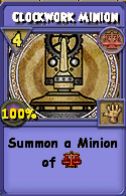 This minion only comes as a pet card. It has the potential to be called the King of minions. While not as strong as Talos in direct comparison, this card can be argued to be even more effective if you scale it to lower levels. This means that this minion can cause more problems to adept players than Talos can to legendary players for example.
This minion only comes as a pet card. It has the potential to be called the King of minions. While not as strong as Talos in direct comparison, this card can be argued to be even more effective if you scale it to lower levels. This means that this minion can cause more problems to adept players than Talos can to legendary players for example.
The Clockwork has more health than the Mander and a few extra tricks under its sleeve. While it doesn’t have a 3 pip attack, it has Spectral and Spirit Blast. Just like Sandstorm, these hits cost 4 pips. The difference is that the Clockwork Minion can’t donate pips, which means he’ll have an easier time reaching 4 pips, which allows him to attack your opponent.
Utility wise, the Clockwork is also a beast of a minion. It can cast shields, weaknesses, mantles, and blades. And on top of all that, it can also use a spirit or elemental spear. While spears aren’t quite as useful as blades, it never hurts to get a free 6% extra pierce for your next attack.
Death
Animate
Animate is an interesting and tricky minion to use. It uses all your pips and in return gives you a minion with (amount of pips) × 100 health. So, using this minion with 3 pips will result in a 300 hp minion. Likewise, using 10 pips will result in 1000 hp minion. And while more expensive minions do have better health and stronger spells, they aren’t really worth summoning.
The reason that the high-pip minions are so weak is the tempo and pip war that occurs in PvP matches. Say you spend 10 pips to get this minion out. This same minion will die with your opponent’s 4 pip spell. It will automatically put you in a big disadvantage. That’s why it’s best to get the 4 or 5 pip minion. It has a decent pip cost and health, it can spam weaknesses/plagues and it can land the occasional fire elf to get rid of shields.
Fire
Fire Elemental
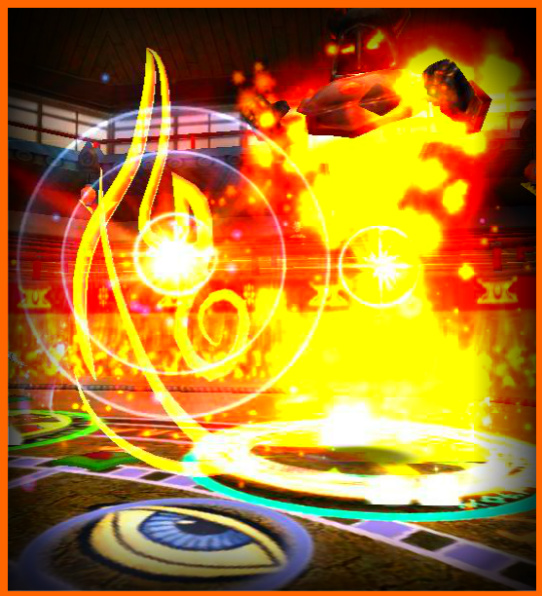 This is hands down one of the most annoying minions that can be put on the field. Not only can it be a nightmare with its mantles, it also loves to spam Links and Fire Elves.
This is hands down one of the most annoying minions that can be put on the field. Not only can it be a nightmare with its mantles, it also loves to spam Links and Fire Elves.
The Fire elemental’s defensive arsenal is not too shabby either. He can use fire set shields or ice/storm shields. As such, it can be a good defensive utility vs elemental schools. There is also the Sprite spell it knows that can help it stay alive or give you a slight boost of health.
Ice
Ice Guardian
The Ice school is mostly defensive, so ice wizards received a really offensive minion. It’s there to bring some aggression into their generally defensive gameplay. The Ice Guardian can blade, trap and use up to 3 pip attacking spells. It can use Ice Bats or Snow Sharks – both spells deal a bit more damage than their 2 and 3 pip Ice school counterparts.
While damage from minions isn’t as big of a problem as the player’s damage, this can quickly spiral out of control. Under the Ice bubble and with blades up, these seemingly-innocent Snow Sharks can pack a punch. Especially at lower levels this can be deadly, when the maximum amount of health isn’t very high.
This minion’s constant aggression and stream of attacks will make sure that your opponent will have a hard time establishing defenses with either tower or set shields.
Life
Sprite Guardian
This little minion has only 350 health and costs 4 pips. It’s rather expensive for how fragile it is, but it’s a healing machine. If it remains on the field, it can provide a nice and steady stream of heals. The best part is that it can bring you back to life when it casts a healing spell on you the same round that you die. Even better, this cute little thingy can even use Satyr!
Its offensive tools are generally only capable of scratching your opponent. While it won’t be as threatening as the Ice Guardian, it does its job by clearing up your opponent’s shields.
Myth
Golem
While all minions can be described as “Cannon Fodder”, this one takes the crown in this category. It costs zero pips and even a level 1 wand hit can kill it (it has 45 health). Although it can use only rank 1 attacks, this minion really is a deadly tool on the field.
Since it costs zero pips, it’s a win-win scenario. In the worst case scenario, your opponent will use a wand to kill it. This means they have one less wand strike to get rid of tower shields or weaknesses. Sometimes your opponent will even use 2 or 4 pip attacks to kill the innocent Golem. They can also wait long enough that the rank 1 attacks will start breaking their shields. All of these are great scenarios!
Troll
The troll minion costs 1-3 pips. If you have 3 or more pips, you’ll always spend 3 pips and summon the 3 pip version. The 1 and 2 pip versions can be summoned only when you don’t have enough pips for the better minion.
Overall, Troll isn’t that bad of a minion and can cause some problems at lower levels. Unfortunately, this one is quickly replaced by Cyclops Minion, which is basically a stronger and better version of this card.
Cyclops
This beast has same mechanic as the Troll Minion, only it goes up to 4 pips. And boy, this extra pip minion makes a difference! For merely 4 pips, you get a minion with 700 hp!
At lower levels, this minion can be really painful to kill. It requires a lot of effort and can easily be replaced once it dies. It has some great moves: it can blade you or itself. Its attacks are great shield breakers with occasionally a nice damage spike (a bladed cyclops for example).
The ace in this minion’s sleeve is definitely spritely. At lower levels it’s a little difficult to one-shot this creature, which means that it will have time to recover and gain an additional 300 hp by healing itself.
Minotaur
This is one of the most overlooked minions. The reason is that it doesn’t hit often or offer any utility. The minotaur can cast a tower shield, but uses it mostly on itself. It likes to taunt, which is useless when you’re playing vs humans. Its absorb and spritely spells often land on itself as well.
Because of these reasons, the minion will often get ignored by your opponent. This means occasionally getting a free tower shield, heal or absorb on yourself as well the occasional shield breaker. If your opponent has a minion up, Minotaur’s taunt will be good enough to attract the opponent’s minion’s attention on himself. Consequently, you will be able to focus on your opponent only.
So, overall it’s not bad minion by itself. It’s just that the Myth school has so many other good minions. With such a big variety there is often a better alternative available than the lovely Minotaur.
Van Der Borst
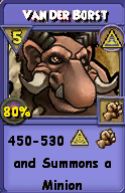 It’s quite possible that many of you didn’t even know that this minion exists. It comes only as a pet card from the Rude Goblin pet and you won’t see it around the arena very often.
It’s quite possible that many of you didn’t even know that this minion exists. It comes only as a pet card from the Rude Goblin pet and you won’t see it around the arena very often.
The card itself deals 450-530 damage and summons either a Fire (450 hp) or a Myth (550 hp) minion. These minions are nothing special, since they have only a blade and a trap as utility spells and few attacking spells.
The situation with this minion is exactly the same as with Minotaur. Its opportunity costs are simply too large. You could simply use another, better minion, and in addition get yourself a different, more useful pet card.
Talos
So here we are! The best minion ever. For only 5 pips you get a minion with 1000 hp (with extra resist for Myth attacks). Pair this with a tower or two from your hand and you’ve unleashed an ultimate nightmare for your opponent. Talos is a decent choice even at max levels and a super good option at mid levels.
Talos can blade or hex and — what is even more important — it can stun opponents. Everyone pretty much instantly stun blocks when facing the Myth school, so having a Talos up puts some extra pressure on them. If that’s not enough, this minion also loves to use Humongofrog in order to help you clean your opponent’s minions. In some rare cases you’ll even see it using an Earthquake!
Witch’s House Call
This card has the same mechanic as Van Der Borst. It hits the opponent (and it will hit hard) and summons a minion afterwards. It’s a great way to add some distraction to the field after already have given a hard hit.
You can receive one out of three minions: a buffer, a debuffer or a healer. All of them also have a natural attack, so they can function as your free shield clearing service. Other than that, they’re just a nuisance that has the possibility to turn the battle to your advantage.
Storm
Water Elemental
This is another minion people overlook easily. Firstly, it has a bad past, as this minion used to be horrible. However, it received a buff, and since then, it can cast some nice and fancy spells. Despite the buff, you still won’t see this minion played too often, because Storm is such an aggressive school. Often, it’s simply not worth summoning a minion because the match will often be over before the minion has the chance to do something useful.
When it comes to its spells, this minion can cast elemental shields, absorbs and spritely (and he loves to taunt!). These spells will mostly be aimed at the minion itself, but sometimes it will feel generous and share his stuff. However, that’s not all! Here’s the interesting part: when this minion received a buff, a natural attack was added to its arsenal. This is a great addition for a school like Storm that struggles with shields. Another spell this minion can use is Disarm, which fits pretty nicely since storm isn’t really known as a school that can survive for too long.
Are you using minions in PvP?
Which one is your favourite?